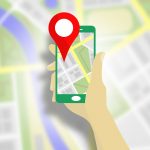
My Maps is an online platform by Google that allows you to personalize your Google map and also add multimedia information to different locations. It is important to consider student data privacy when using non-Canadian housed resources (FIPPA). In some cases, school districts have permissions in place for the use of google classroom, while in others, it would be wise to have students utilize a class login if adding to the map (and, of course, ensuring this is appropriate in your district/school). It is important to ensure students develop digital literacy and know what kind of information is safe to share and what isn’t. Valuable contextual learning can take place when students have the opportunity to create in online environments at school with a teacher who is conscious of the issues and possibilities.
My Maps can enhance place-based learning and learning about place by providing a space for students to upload images, text and audio connected to a specific location in the world. They can be used by teachers to create guides or presentations for students allowing them to explore and discover different areas and information. Creators and contributors of maps can tie in their own images to create a more personalized and interactive experience than a more linear slideshow or video affords. Viewers of the map can click on the tags including text, videos, and weblinks, creating a more interactive and non-linear experience than a more traditional presentation, video or slideshow might afford.
One example of an excellent use for an online collaborative map is this Eco-poetics project: Poems from the Garden.
- Sign into your Google Account.
- Click on “Maps” (Depending on your browser, you may need to select the ‘gear’ icon after logging in before you can see ‘My Maps’).
- from the ‘menu’, select ‘your places’ and select ‘Maps’ – scroll to the bottom, select ‘create’.
- Title the Map.
- Select your privacy option for the map using the sharing icon (public, private, viewable or editable by anyone with link or by invitation, etc)
- Public (shared with everyone online)
- Unlisted (shared only with people to whom you provide the URL/Map address)
- Share the URL of your map.
- Click on ‘Link’ in the upper right-hand corner of the map. You can copy the link and share it with others. You may even copy the ‘embed code’ and paste it into your website.
- NB: Individuals with the URL can view the map but cannot edit the map (i.e. add markers) unless they are logged into their Google Accounts.
Adding a marker
- Login to My Map.
- Find your location.
- Zoom in to your location (using the +/- or by double clicking on the map) or find your location using the ‘Search bar
- Select the ‘Marker’ tool (from the toolbar below the search bar).
- Click on the location where you would like to place the marker.
- Type your title and description.
- Add an image.
- Change the icon to one of many custom icons in the app.
Teaching Tip: To help protect student privacy, create a class Google account that students can use to login so that they do not need to set up and use individual Google accounts.

